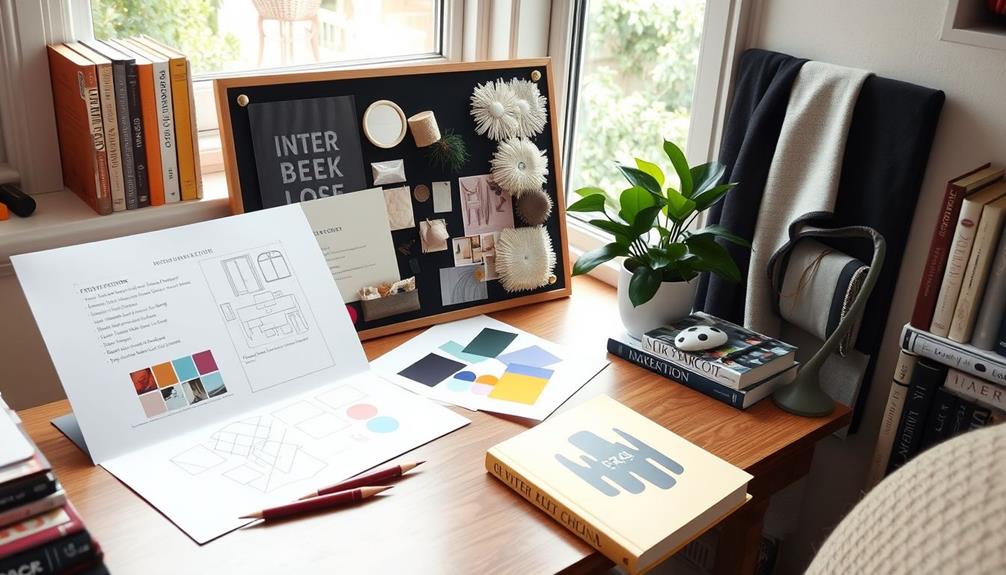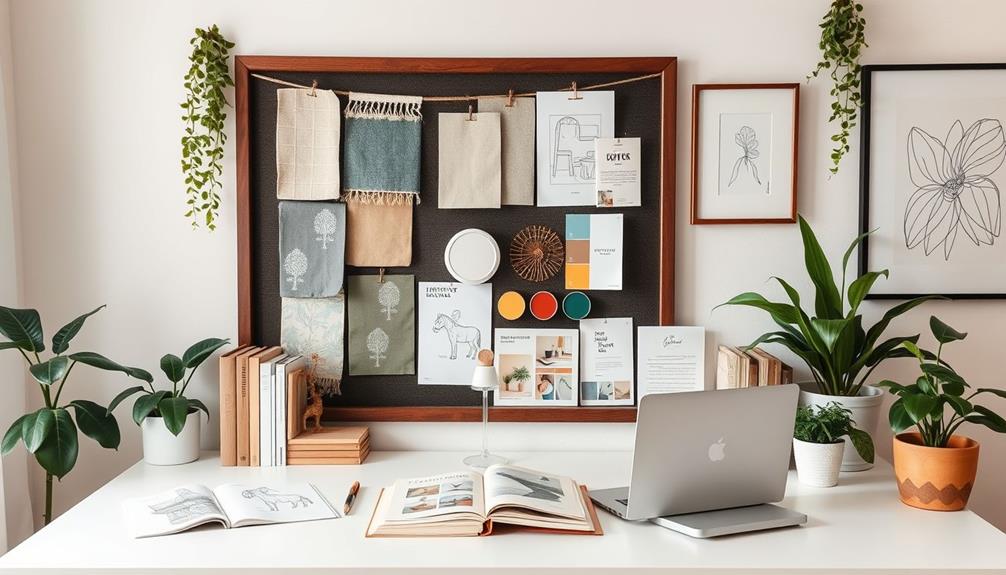You can learn interior design at home by exploring various online resources. Start by mastering the basics, like color theory and space planning. Platforms like Coursera and MIT OpenCourseWare offer free courses to solidify your foundation. Create mood boards on Pinterest to visualize your ideas and experiment with different styles. Utilize design software such as AutoCAD and SketchUp for practical applications. Engage with online design communities for feedback and support. Don't forget to build a diverse portfolio to showcase your projects. You'll find even more tips and insights to enhance your learning journey as you explore further. Seek out additional resources such as free online interior design courses from reputable institutions like the New York School of Interior Design and the Rhode Island School of Design. These courses can provide in-depth knowledge and hands-on experience to further hone your skills. Remember to stay updated with the latest interior design trends and technologies to stay ahead in the field.
Key Takeaways
- Master color theory and space planning to create functional and aesthetically pleasing environments in your home.
- Utilize free online resources, such as Coursera and YouTube, for structured courses and practical design techniques.
- Create moodboards with tools like Pinterest to visualize your design ideas and explore complementary color schemes.
- Familiarize yourself with essential design software like AutoCAD and SketchUp Pro through tutorials and community forums.
- Build a diverse portfolio showcasing various projects to reflect your skills and design philosophy for potential clients or employers.
Understanding Interior Design Basics

To plunge into the world of interior design, it's essential to grasp the basics that form the foundation of this creative field. Start with color schemes; understanding color theory can greatly influence the mood of a space. Familiarize yourself with the color wheel and the psychological effects of warm, cool, and neutral colors. By mastering these concepts, you can select palettes that evoke the desired atmosphere in any room.
Incorporating elements from various design styles, such as farmhouse charm, can also enhance your understanding of how different aesthetics can coexist within a space.
Next, focus on space planning. This involves considering the room's dimensions and guaranteeing that furniture scale and proportion are appropriate. Creating a functional layout enhances flow and usability, making a space comfortable and inviting.
Think about furniture selection too. Prioritize durability, functionality, and style consistency to guarantee each piece harmonizes with your overall design vision.
Additionally, don't overlook the importance of lighting design. A layered approach incorporating ambient, task, and accent lighting can transform a space, setting the right ambiance while enhancing its aesthetic appeal.
Exploring Free Online Resources

With a solid grasp of interior design basics, you can now take advantage of numerous free online resources that make learning even more accessible. Platforms like Coursera, edX, and MIT OpenCourseWare offer free online courses covering essential principles like color theory and space planning. These courses provide structured learning that can help you deepen your understanding.
Additionally, websites such as Decorating Studio and HGTV offer practical guides and tutorials without requiring registration, ensuring that you can engage with design concepts without barriers. YouTube is another treasure trove, hosting instructional videos on various design techniques, from sketching to DIY projects, catering to diverse learning styles.
To enhance your hands-on experience, consider using free design software tools like HomeStyler and RoomStyler. These platforms enable you to visualize and plan your spaces, bringing your ideas to life.
Engaging with online design communities and forums also fosters collaboration and feedback, enriching your learning experience. By connecting with peers and professionals, you'll gain valuable insights and support as you commence your interior design journey.
Embrace these resources and watch your skills flourish!
Recommended Courses and Platforms

Many aspiring interior designers find that enrolling in structured courses can considerably enhance their learning experience. If you're looking for recommended courses, platforms like Coursera and edX offer numerous free online courses covering essential concepts like color theory and space planning. These platforms provide access to expert instructors and allow you to receive peer feedback, which can be invaluable.
For a more academic approach, check out MIT OpenCourseWare's free course on Principles of Design, where you'll explore essential topics like lighting and design history at your own pace.
If you're a beginner or want to advance your skills, the Home Design Institute in Paris features a variety of online courses catering to different levels of expertise.
Don't overlook YouTube as a resource, either. It's packed with instructional videos that cover everything from sketching techniques to furniture arrangement tips.
Building Your Design Skills

As you immerse yourself in the world of interior design, honing your design skills becomes vital for turning your creative vision into reality. To elevate your skills to the next level, you can explore various resources and strategies that enhance your understanding and execution of design concepts.
Consider incorporating elements of Cottagecore Home Office aesthetics, which blend rustic charm with productivity, into your design projects.
- Enroll in free online courses from platforms like MIT OpenCourseWare and Coursera to grasp basic design principles at your own pace.
- Utilize design software like AutoCAD and SketchUp Pro through free tutorials, which will help you develop technical skills that are essential for project execution.
- Regularly follow design blogs and influencers to stay updated on current trends and gain fresh design tips, allowing you to incorporate new ideas into your projects.
Additionally, consider creating moodboards using tools like Pinterest to visualize design styles and color schemes.
Engaging with online design communities can also provide valuable feedback and insights from industry professionals and fellow learners.
Utilizing Moodboards and Color Theory

Moodboards are your best friend when it comes to visualizing your design ideas, helping you see how different elements come together.
Understanding color psychology is equally important, as it influences the emotions and atmosphere of a space.
Importance of Moodboards
Harnessing the power of moodboards can transform your approach to interior design. These visual representations are essential for clarifying and communicating your design concepts, especially when it comes to color schemes and materials. By utilizing moodboards, you can explore various design elements and develop a cohesive aesthetic by identifying common threads in your selections.
Here are a few reasons why moodboards are so important:
- They help you visualize and refine design concepts before implementation.
- They encourage the exploration of complementary colors, enhancing the overall mood and harmony of a space.
- They make decision-making easier by mixing existing items with new inspirations.
Using tools like Pinterest or digital moodboard applications simplifies the process of compiling your inspiration. This way, you can easily create a mood board that showcases your ideas, ensuring everything aligns with your vision.
Ultimately, moodboards serve as a bridge between your imagination and the final design, guiding you toward a more focused and successful interior design project. Embrace the importance of moodboards, and watch your design skills flourish!
Understanding Color Psychology
Color psychology greatly influences how we experience spaces, shaping our emotions and behaviors. When you're designing your own home, understanding how different colors impact mood is vital. Warm colors like reds and yellows can energize a room, while cool colors such as blues and greens create a calming atmosphere.
To help visualize your ideas, using a color wheel alongside moodboards can be invaluable. Here's a quick reference for the emotional impact of various colors:
| Color | Emotion/Effect |
|---|---|
| Red | Energy, passion |
| Yellow | Happiness, warmth |
| Blue | Calmness, tranquility |
| Green | Balance, growth |
| Purple | Creativity, luxury |
When designing your own home, it's also important to test paint samples in different lighting to guarantee your desired ambiance. Incorporating textures and patterns alongside your color choices adds depth and engagement, enhancing emotional resonance within the space. By mastering color psychology, you'll create an environment that reflects your style while positively impacting your mood and well-being.
Essential Design Software Tools

To excel in interior design, you need to master essential software tools that streamline your workflow and enhance your creativity.
Programs like AutoCAD LT and SketchUp Pro are crucial for creating detailed layouts and visualizations, while Adobe Creative Suite can elevate your presentations.
Exploring user-friendly platforms and online resources can help you quickly gain the skills necessary to bring your design ideas to life.
Must-Have Design Software
When diving into interior design, having the right software tools at your fingertips can truly make a difference in your creative process. To elevate your skills and approach projects like a professional interior designer, familiarizing yourself with must-have design software is essential.
Here are some essential tools to reflect on:
- CAD Software: Programs like AutoCAD LT and SketchUp Pro are crucial for creating detailed floor plans and 3D visualizations.
- Adobe Creative Suite: Tools like Photoshop and Illustrator allow you to design stunning presentations and marketing materials that captivate clients.
- 3D Modeling Software: Engaging with platforms such as 3ds Max or Blender enhances your ability to visualize complex designs effectively.
Additionally, don't overlook project management tools like Trello or Asana to track tasks and timelines, ensuring efficient project execution.
For those on a budget, free tools like HomeStyler and Floorplanner provide excellent options for space planning without hefty investments.
Embracing these software tools won't only streamline your workflow but also enhance your design capabilities as you learn and grow in the world of interior design.
Learning Software Resources
Having the right software tools at your disposal can greatly enhance your journey in interior design. Familiarize yourself with essential design and architectural software like AutoCAD LT and SketchUp Pro. These tools are invaluable for creating detailed floor plans and 3D models. To boost your skills, utilize free online resources and tutorials that explore software features.
Engaging with online communities or forums can also be beneficial. You can share tips, ask questions, and learn from experienced users and industry professionals. Additionally, practice using project management tools alongside design software to keep tasks, timelines, and client interactions organized.
Consider exploring other software options like Adobe Creative Suite for graphic design elements, which can elevate the quality of your presentations. Here's a quick overview of some key software tools:
| Software | Purpose | Learning Resources |
|---|---|---|
| AutoCAD LT | Floor plans | Online tutorials, forums |
| SketchUp Pro | 3D modeling | YouTube videos, community support |
| Adobe Creative | Graphic design elements | Free courses, design blogs |
These tools will help you on your path to learn interior design effectively.
Software for Visualization
Understanding the importance of visualization in interior design is key to effectively communicating your ideas. By using the right software, you can bring your concepts to life, making it easier for clients to grasp your vision. Familiarizing yourself with essential design software like AutoCAD LT and SketchUp Pro is vital, as these tools allow for precise drafting and 3D modeling of interior spaces.
Additionally, utilizing tools that promote user engagement and community building can enhance your design process and client interactions, as seen in WordPress features and functionalities.
Here are some important software tools to keep in mind:
- AutoCAD LT: Great for detailed 2D drafting.
- SketchUp Pro: Excellent for 3D modeling and visual representation.
- Adobe Creative Suite: Enhances your graphic design and presentation elements.
Additionally, engaging with 3D modeling software not only improves your design visualization but also aids in better spatial planning and client presentations.
Don't forget to explore free online tutorials on platforms like YouTube; they can provide you with valuable insights into mastering these software tools.
Finally, think about incorporating project management software to streamline your workflow, ensuring your tasks and timelines are organized for efficient project execution.
With these tools in your arsenal, you'll elevate your design skills greatly.
Creating a Personal Portfolio

In today's competitive interior design landscape, creating a personal portfolio is essential for showcasing your unique style and skills. Your portfolio should include a variety of design projects, such as sketches, mood boards, and completed room makeovers. This diversity demonstrates your versatility and creativity. Don't forget to include before-and-after photos, as they visually highlight your ability to transform spaces, capturing potential clients' or employers' attention.
Organize your portfolio thematically or by project type. This structure allows viewers to navigate your work easily and understand your design philosophy. Utilize online platforms like Behance or personal websites for a professional presentation, ensuring your work is accessible to a broader audience.
Regularly update your portfolio with new projects and skills, reflecting your current capabilities and trends in the industry. Here's a simple table to help you organize your portfolio effectively:
| Project Type | Description | Visuals |
|---|---|---|
| Living Room | Modern soft furnishings | Before-and-after pics |
| Kitchen | Functional layout | Mood boards |
| Bedroom | Cozy designs | Sketches |
| Office Space | Ergonomic solutions | Completed makeovers |
| Outdoor Area | Relaxing environments | Concept visuals |
Creating a personal portfolio is your gateway to success in interior design!
Conclusion
Now that you've got the basics down and explored various resources, it's time to dive deeper into your interior design journey. Imagine the thrill of transforming a space with just a few design principles! As you build your skills and create that stunning portfolio, remember: your unique style is waiting to be discovered. What will your next project look like? With each step, you're not just learning—you're crafting your design destiny. So, what's stopping you?









